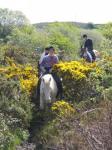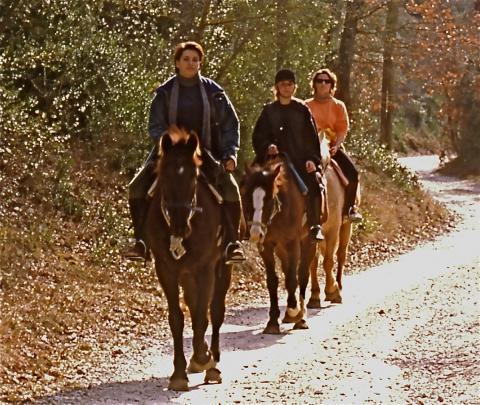Golf is a life-long interest for many men, but it leaves behind many widows. More and more, though, golf widows are finding their own passions at a rapidly increasing number of equestrian centers inside golf communities. [Editor's note: This past week, I visited two such communities in the Low Country of South Carolina, Spring Island and Oldfield. I will review both in coming days.] Equestrian centers in golf developments range from "world class," which include impressive indoor arenas and concierge-level services, to small, informal barns with facilities limited to an outdoor ring and trails, and minimal other services.
How should a prospective resident evaluate an equestrian amenity to assure she will be happy there for the long term? Here are a few things to consider:
- Look for options similar to the service and cost levels you expect in other amenities. For example, expect to pay considerably more for services covering complete care of your horse than if you are willing to be more of a hands-on owner.
- Look for age-appropriate emphasis in planned equestrian activities and
 facilities. Jumping involves a willingness to occasionally hit the ground and requires vigorous, athletic riding -- generally better suited to the under-45 crowd. Lower-level dressage, reining and trail riding appeal to the over-45 to 70-something crowd, which is a fast growing riding demographic. Inquire whether the facility you are considering includes these riding disciplines, as well as a nice trail network.
facilities. Jumping involves a willingness to occasionally hit the ground and requires vigorous, athletic riding -- generally better suited to the under-45 crowd. Lower-level dressage, reining and trail riding appeal to the over-45 to 70-something crowd, which is a fast growing riding demographic. Inquire whether the facility you are considering includes these riding disciplines, as well as a nice trail network.
- If you are looking at a community that has an equestrian amenity on the drawing board, make sure you review a comprehensive written "standard of care," outlining programs offered and related fee structures. A horse care program without guidelines can change dramatically with a new manager; the result could be a lack of stability and harmony "in the barn."
- Young horse people, fresh out of school or certification courses, may not have the experience to deal with horse or rider emergencies. Look for a seasoned horse professional as barn manager, someone who has experience equal to the golf club manager or other managers. Outside riding coaches and clinicians, as opposed to just one in-house trainer, provide a diversification that shows a community is serious about its equestrian program.
- Unless you plan to leave the care of your horse and tack to the management, you will want separate tack lockers and multiple convenient places to groom and tack your horse. If you use a common tack room, expect to have your possessions ‘borrowed', which is aggravating. Having your space is important, the feeling that the barn is YOUR home barn, which in fact it is. Likewise, multiple turnouts and numerous arenas, even if very simple, give everyone the space to enjoy their time at the barn.
- Finally, a few community-owned horses -- the quiet, easy-riding kind -- are real assets. They spread the equestrian experience (and cost factor) more widely among the general residents, offer new riders a chance to try horse ownership on a limited lease basis, and provide fun for visiting relatives. There are several breeds of horses that travel so smoothly that their riders could drink coffee at a trot speed. These horse breeds are rapidly gaining popularity as they deliver true riding pleasure for non-riders -- even the occasional golf widow's husband.
Stacey Adams, who provided the photos, is a travel consultant who specializes in trips that involve both golf and horse riding. Ms. Adams is currently offering a Sunday through Friday trip to Gleneagles in Scotland for $2,800.00 per person in a shared room. The trip, which is available weekly, includes full Scottish breakfast, table d'hote dinner and three daily 45-minute semi-private riding lessons or two rounds of golf for each guest per day. For more information, contact Ms. Adams at 800.973.3221.




